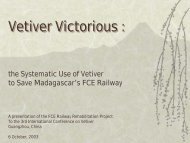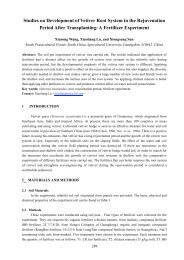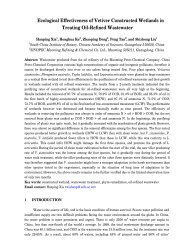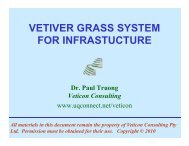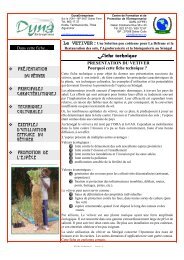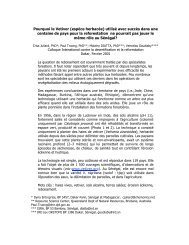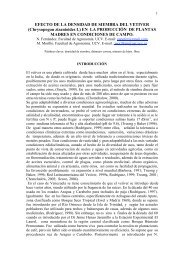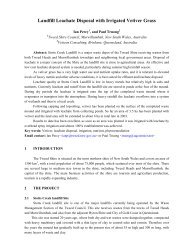Power Point - The Vetiver Network International
Power Point - The Vetiver Network International
Power Point - The Vetiver Network International
Create successful ePaper yourself
Turn your PDF publications into a flip-book with our unique Google optimized e-Paper software.
<strong>Vetiver</strong> System for Stream Bank Stabilisation(With special references to the river and canal bank stabilisationin Australia and Vietnam)Paul TruongDirector, <strong>The</strong> <strong>Vetiver</strong> <strong>Network</strong> <strong>International</strong>,Veticon Consulting, Brisbane, Australia.
Stability of Stream and Water Retaining Structure Banks1. As in the case of dry land slopes the stability of stream bank is basedon the interplay between the driving forces which promote downslope movement, while resisting forces deter movement.2. However, erosion of water retaining structures are more complicated.it increases driving forces by:• Eroding the base of slopes by wave action, which removesthe support.• Loading, that is, filling previously empty pore spaces andfractures, which adds to the total mass subjected togravitational force.• Reducing the shear strength of the slope material• Interacting with surface rock and soil, slowly weakeningslope material, and reducing its shear strength. Thisinteraction reduces resisting forces.3. Failure occurs when erosion of the bank toe and the channel bed haveincreased the height and angle of the bank to the point thatgravitational forces exceed the shear strength of the bank material.
Special Characteristics of <strong>Vetiver</strong> Suitablefor Stream Bank Erosion Control• As a wetland plant, <strong>Vetiver</strong> withstands prolongedsubmergence. In Cambodia, <strong>Vetiver</strong> survived longer than fivemonths under the muddy Mekong River water.• Given its extraordinary root depth and strength, mature <strong>Vetiver</strong>is extremely resistant to washouts from high velocity flow.• Under shallow or low velocity flow, the erect and stiff stems of<strong>Vetiver</strong> act as a barrier that reduces flow velocity and trapseroded sediment. It can maintain its erect stance in a flow asdeep as 0.6-0.8m.• <strong>Vetiver</strong> leaves will bend under deep and high velocity flow,providing extra protection to surface soil while reducing flowvelocity.• When planted on dams or dikes, <strong>Vetiver</strong> hedgerows helpreduce the flow velocity, decrease wave run-up.• <strong>The</strong>se hedgerows also help reduce retrogressive erosion thatoften occurs when the water flow or wave retreats after it rises.
Indoor flume testWater levelWater trickles downPC: Seth Dabney
In flume test a mature hedge can bank up water to 600mmdepthWater level
Water flows over bent leaves and stemsPonding heightWater flows overWater level
Where:q = discharge per unit widthy = depth of flowy1 = depth upstreamSo = land slopeSf = energy slopeNf = the Froude number of flow.
Appropriate Designs and TechniquesAs in dry land erosion control, appropriate designs andtechniques should be adhered to for successful stream bankserosion control.For flood mitigation and coastal, riverbank anddike/embankment protection, the following layout specifications arerecommended:• Maximum bank slope should not exceed 1.5(H):1(V).• Recommended bank slope is 2.5:1.• <strong>Vetiver</strong> rows should be planted in two directions, oneparallel to flow direction (horizontal), for bankstabilisation and the other right angle to the flow toreduce flow velocity• <strong>The</strong> first horizontal row should be planted at thecrest of the bank and the last row should be planted atthe low water mark of the bank.
Some examples of failures of traditional river bankprotection in VietnamSoft structureSoft structure:Using the waterhyacinth barrier.But Erosioncontinuesbehind itTrees are of not much help either.
Native grass is equally ineffective.Soft structurePhragmites sppFrom the front it looks likethis bank is well protected.But erosion continues aswaves from unprotectedsection upstream gotbehind it.
Soft structureSome examples of river bankand coastal erosion controlwith bamboo, casuarinasand coconut trees
Hard structureHard structure:Concrete plate cover on river dike
River and Canal Bank Erosion Controlin Australia• Bridge Abutment• Drainage channel at Laidley
Stream bank erosion control in Australia: Bridge abutment
Severe erosion on the abutment of the Coolumboola Creek
Severe erosion on the abutment of the Coolumboola Creek
<strong>Vetiver</strong> planted after reparationFlow direction
18 months after planting, no more erosion on the whole site
Five years after planting and after several flash floodsYellow leaves due towinter frostNote the bare areabetween rows. No otherplants have survived
Stabilisation of creek bank of a Dam spillway<strong>Vetiver</strong>
One year after planting<strong>The</strong> water is brackish
300 cumecs100cumecs<strong>Vetiver</strong> rowsFlood erosioncontrol in drainagechannel<strong>Vetiver</strong> hedges wereestablished to spreadwater out and also todivert water to the drainDrainage Channel
FlowLooking sideway towards the channel opening
A big storm hit the area 3 months after planting and the whole sitewas flooded (Upper section)
Very fast flow flattened and inundated most of the hedges. <strong>The</strong>velocity was estimated up to 5m/sec in some areas
merged <strong>Vetiver</strong>dgesDrainage channel
Although only 3 month old, the young hedges provide a very effective protectionwith only minimal erosion at the head of the channelSmall erosion
Trapping sedimentStrong flowexposed part of thecrowns but failedto dislodge theplants
General view of channel seven weeks after flooding
River and Canal Bank Erosion Controlin Vietnam• Failure of rock basket and gabiontechnique• Success of the <strong>Vetiver</strong> System
THE VERY COSTLY ALTERNATIVE• Rock walls, rock baskets or rip rap are traditionalmethods used for riverbank stabilisation in Asia,particularly in China and Vietnam.• <strong>The</strong>se methods are high-tech engineering structures,requiring special skill and high maintenance costs• <strong>The</strong>se methods are much more expensive, may beseveral thousand times more in the case of the Mekongdelta as rock is not available locally and some importedmaterials are required• But most importantly they are not effective as they arenot stable themselves on the alluvial plains of Asia. <strong>The</strong>following photos show their ineffectiveness and high costs.
Viet Nam: <strong>The</strong> levee bank of the Red river in Hanoi
Gabions and rockbaskets are being usedto repair recent flooddamages whichthreatened the leveebank of the Red RiverA very elaborateand costlyengineeringstructure, theserocks came fromfar away quarriesRock basketRock rip rap
But this method provided no protection as this bank had been previously coveredby similar rock baskets. Remnants of the old rocks which collapsed in the lastflood, were still visible in the river.Remnants of the old rockbaskets
Consultant Report on costs of riverbankstabilisation in AustraliaSummary of the Impacts and Costs Associated ofVarious OptionsOptionsEstimated Cost($)EnvironmentalImpactsNative vegetation 10 000 Low<strong>Vetiver</strong> grass 15 000 LowDumped riprap 195 000 LowRock mattresses 272 500 MediumRock groyne 251 250 LowConcrete pile wall 1 700 000 Medium
Flash flood protectionLevee bank protection in centralVietnam
An irrigation canal in bad shape incentral Vietnam<strong>The</strong> same site at planting andafter several months.
Prawn farm (Brackish water)dike protection in centralVietnam<strong>The</strong> same site after severalmonths.
Flood protectionFlood control dike protectionin the Mekong Delta VietnamWater level on the dikeduring flood seasonDike during flood>10mLevel during dry season
A precious piece of land 5m wide is kept intact due to <strong>Vetiver</strong>
With <strong>Vetiver</strong>Without <strong>Vetiver</strong>
Eucalyptus is not effectiveWith <strong>Vetiver</strong>
With wooden structureCan act aloneOr with concrete/rock rip-rap structures.
Sea Dikes in northVietnam
Sea Dikes in southVietnam<strong>Vetiver</strong> protecting sea dike behindthe mangrove.
Riverbank Erosion Controlin Other CountriesSome examples of VS used in riverbankstabilisation in Cambodia, China,Malaysia, the Philippines, South Africa.
CambodiaErosion on the bankof the Mekong river
Cambodia <strong>Vetiver</strong> planting following earth shaping
Cambodia Eight month after planting
CambodiaAnnual flooding withdepth level between15-20m
under 15mFlood levelCambodiaWater receded 5 monthsafter flooding:- the lowest rows (15m)was dead but its rootsremain intact and stoperosion- the mid section(8m) survived andresume growthafter waterrecededunder 8m
Malaysia: An outstanding success, several floods did notdamage this riverHorizontal rowsCross rowsDiti Hengchaovanich
South Africa: A very well layout provided complete protectionagainst erosion
China: Highly erodible and badly eroded of the oftenflooded shore line of Lake Evergreen in Guangdong
This section of the bank has been successfullystabilised by vetiver grass in a trial
.Philippines: <strong>Vetiver</strong> was planted to protect the bankof Abra River against flood erosionEd Balbarino
One year after planting, the bank was successfully stabilisedEd Balbarino
THANK YOU




